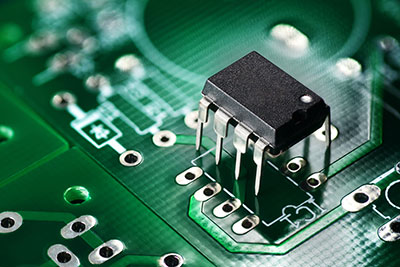In electronics, a "through hole" refers to a type of mounting technology used to connect electronic components to a printed circuit board (PCB). Through-hole technology involves drilling a hole through the PCB and inserting a wire or pin through the hole, which is then soldered to the board on the other side. This provides a secure mechanical and electrical connection between the component and the PCB.

Through hole technology once dominated as the electronics assembly technique from the 1950’s until the 1980’s when SMT (surface-mount technology) rose to prominence. During that period, every component on a PCB was a through hole component.
Since then, SMT’s have enjoyed wide adoption for their advantages over TH components and changing technology requirements. Plated-through holes are no longer required with SMT boards for making the component connections, but are still used for making interconnections between the layers and in this role are more usually called vias.
There are two types of components that belong to the TH category: axial and radial. Axial components feature wire leads at both ends, while radial components have wire leads that extend from the bottom of the device.
During the testing and prototyping phases, these components are particularly valuable due to the frequent need for manual adjustments and replacements. Each type can be converted into the other by bending the leads to mimic the other’s form.
TH components can either be mounted manually or automatically with insertion mount machines. In both approaches, the two leads are soldered onto pads located on opposite sides of the PCB, thereby completing the circuit.
| Pros | Cons |
|---|---|
| Easier prototyping and testing | Requires more expensive drilling |
| Relatively inexpensive | Takes up more space on boards |
| High heat tolerance | Assembly process is more involved |
| Strong physical bonds | Slower speeds |
| High power handling capability |
Surface mount technology has some advantages over thru-hole technology, namely cost, that contribute to its increasing popularity. However, thru-hole mounted components have some distinct features that help them remain the technology of choice for some industries and applications.
The most commonly cited example of thru-hole mounting process benefits is the fact that thru-hole mounted components offer enhanced reliability. Because the leads go all the way through the board in addition to being soldered in place, the bonds are stronger. As a result, the products they’re used in are more resistant to environmental stresses such shock and impacts.
Some types of components are also not yet available in a surface-mount variation, making thru-hole a necessity in some cases.
A modern PCBA design has two main methods for mounting components onto a PCB: Through-Hole Mounting and Surface Mounting. What is the Difference between through hole and surface mount?
Through-hole technology (THT) involves drilling holes in the PCB and inserting component leads through the holes, then soldering the leads to the copper pads on the other side of the board. This method has been used for many years and is still widely used for components that require a high level of durability or mechanical strength, such as power connectors, large capacitors, or components that will experience a lot of stress or strain during use.
Surface-mount technology (SMT) involves mounting components directly onto the surface of the PCB. The components have small metal pads on their undersides that are soldered directly onto the copper pads on the PCB. This method is more space-efficient than through-hole, allowing for smaller PCBs, and is used for components that are smaller and lighter, such as resistors, capacitors, and microchips.
Related Aritcle: A Complete Guide for Surface Mount Technology Manufacturing
So, through-hole technology is more suitable for larger components or those that need to withstand significant mechanical stress, while surface-mount technology is more appropriate for smaller, lighter components and allows for more compact designs.
Our engineering team provides pcb fabrication engineering support. Our team is what sets us apart from the competition. We provide PCB layout and manufacturing evaluation to ensure a smooth process for your product build. Get in touch with us by filling out a contact form today.
By continuing to use the site you agree to our privacy policy Terms and Conditions.
Recruit global agents and distributors Join us